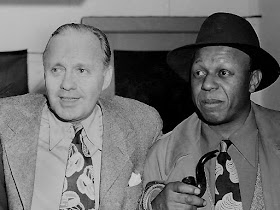 I've been doing some research for a project, and in the process I've learned about the author of Black Like Me, John Howard Griffen. I had no idea he'd led such an interesting life!
I've been doing some research for a project, and in the process I've learned about the author of Black Like Me, John Howard Griffen. I had no idea he'd led such an interesting life!
If you're not familiar with Black Like Me, here's some information regarding it from Wikipedia:
In the fall of 1959, John Howard Griffin decided to investigate firsthand the plight of African Americans in the South, where racial segregation was legal; blacks had been disenfranchised since the turn of the century and closed out of the political system, and whites were struggling to maintain dominance against an increasing civil rights movement.
Griffin consulted a New Orleans dermatologist for aid in darkening his skin, being treated with a course of drugs, sunlamp treatments, and skin creams. Griffin shaved his head in order to hide his straight hair. He spent weeks travelling as a black man in New Orleans and parts of Mississippi (with side trips to South Carolina and Georgia), getting around mainly by bus and by hitchhiking. He was later accompanied by a photographer who documented the trip, and the project was underwritten by Sepia magazine, in exchange for first publication rights for the articles he planned to write. These were published under the title Journey into Shame.
Griffin published an expanded version of his project as Black Like Me (1961), which became a best seller in 1961. He described in detail the problems an African American encountered in the segregated Deep South meeting the needs for food, shelter, and toilet and other sanitary facilities. Griffin also described the hatred he often felt from white Southerners he encountered in his daily life — shop clerks, ticket sellers, bus drivers, and others. He was particularly shocked by the curiosity white men displayed about his sexual life. He also included anecdotes about white Southerners who were friendly and helpful.
The wide publicity about the book made Griffin a national celebrity for a time.
However, before Black Like Me, Griffin had lived a rather extraordinary life. Here's some of what I learned from an article in Smithsonian:
Born in Dallas in 1920, Griffin was raised in nearby Fort Worth. “We were given the destructive illusion that Negroes were somehow different,” he said. Yet his middle-class Christian parents taught him to treat the family’s black servants with paternalistic kindness. He would always recall the day his grandfather slapped him for using a common racial epithet of the era. “They’re people,” the old man told the boy. “Don’t you ever let me hear you call them [that] again.”
Griffin was gifted with perfect pitch and a photographic memory, but his most vital gift was curiosity. At 15, he earned entrance to a boarding school in France, where he was “delighted” to find black students in class but appalled to see them dining with white people in cafés. “I had simply accepted the ‘customs’ of my region, which said that black people could not eat in the same room with us,” Griffin later wrote. “It had never occurred to me to question it.”
Griffin was studying psychiatry in France when Hitler’s troops invaded Poland in 1939. Finding himself “in the presence of a terrible human tragedy,” he joined the French Resistance and helped smuggle Jewish children to England. When he told an informer of a plan to help a family escape, his name turned up on a Nazi death list. Fleeing just ahead of the Gestapo, Griffin returned to Texas in 1941 and enlisted in the Army Air Corps shortly after Pearl Harbor.
While working as a radio operator in the Pacific, he was sent on his own to the Solomon Islands to ensure natives’ loyalty to the American war effort. For a full year, Griffin studied tribal languages and adaptation to the jungle, but still assumed that “mine was a ‘superior’ culture.”
After getting blasted with shrapnel in an enemy air raid a few months before the end of the war, Griffin awoke in a hospital, seeing only shadows; eventually, he saw nothing. The experience was revealing. The blind, he wrote, “can only see the heart and intelligence of a man, and nothing in these things indicates in the slightest whether a man is white or black.” Blindness also forced Griffin to find new strengths and talents. Over the next decade, he converted to Catholicism, began giving lectures on Gregorian chants and music history, married and had the first of four children. He also published two novels based on his wartime experience. Then in 1955, spinal malaria paralyzed his legs.
Blind and paraplegic, Griffin had reason to be bitter, yet his deepening faith, based on his study of Thomas Aquinas and other theologians, focused on the sufferings of the downtrodden. After recovering from malaria, he was walking in his yard one afternoon when he saw a swirling redness. Within months, for reasons that were never explained, his sight was fully restored.
That's just a portion of the article, but I must say his life reads like a novel! To see the entire piece, click here.
Did you know anything at all about John Howard Griffin? Thanks for visiting and have a great week!










